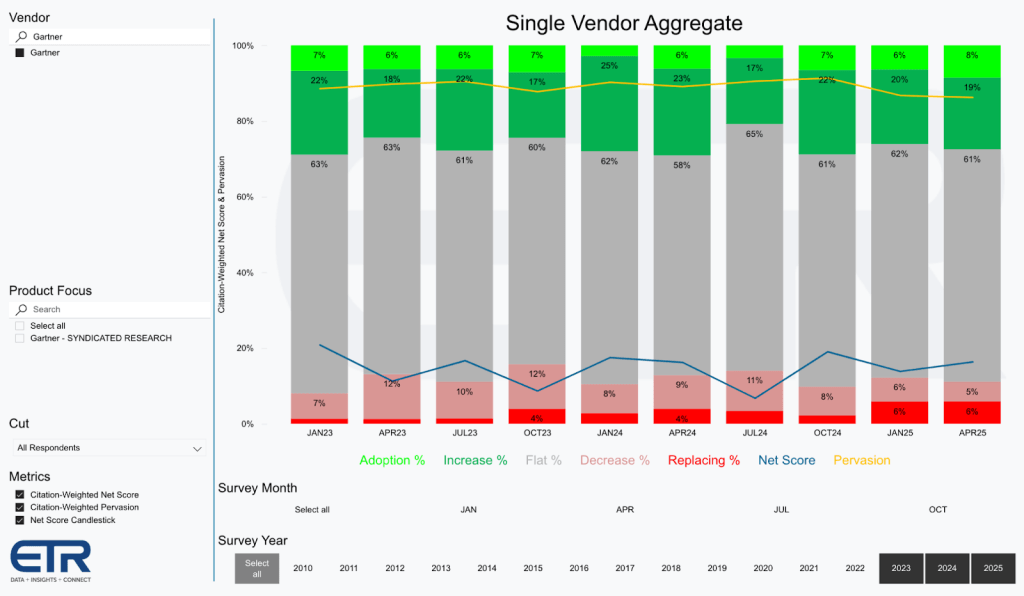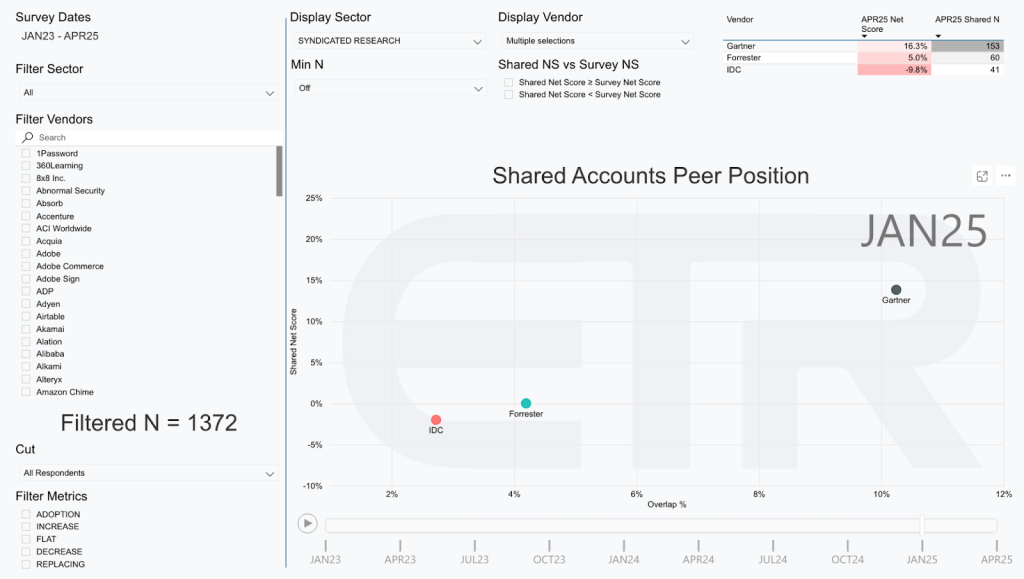 THOUGHT LEADERSHIP
THOUGHT LEADERSHIP
 THOUGHT LEADERSHIP
THOUGHT LEADERSHIP
 THOUGHT LEADERSHIP
THOUGHT LEADERSHIP
The analyst relations function is undergoing a fundamental transformation. Once dominated by a handful of large research houses, such as Gartner, IDC and Forrester, the market now features a spectrum of independent analysts and influencers.
The fast-paced nature of the tech industry, its speed of change, the relentless competition and ubiquity of technology make it a challenging sector for AR practitioners to manage. But perhaps more tricky for AR pros is the dirty little not-so-secret “pay-to-play” and influence peddling services that permeate the analyst business today, creating a caveat emptor dynamic that forces information technology decision makers to be circumspect about strong opinions that are not backed by data.
In this Breaking Analysis, we explore these themes with Erin Zehr, an analyst relations and comms pro who successfully led Dell Technologies Inc.’s AR function to become a best-in-class service within the technology industry, to provide insight into this key pillar of the technology industry.
Watch the full conversation with Erin Zehr:
Analyst relations once occupied a narrowly defined niche, confined primarily to major industry research firms such as Gartner, and on a more limited scale, IDC and Forrester. However, the landscape has shifted dramatically over the past decade. Rapid technological change, more accessible data, podcasts, the rise of independent research analysts, and the advent of influential social media commentators have all created an environment where AR professionals must adapt or risk becoming obsolete. The conversation with former Dell AR lead Erin Zehr offers a unique vantage point on how the modern AR function can remain relevant and even thrive in this era of unprecedented transformation.
This analysis synthesizes Ms. Zehr’s insights on a wide range of topics, including the blurring lines between AR and corporate communications, the influence of independent analysts and influencer figures, and strategies for maintaining trust in a hyper-competitive tech environment. We believe Ms. Zehr’s perspective is particularly valuable given her previous AR experience. Through this lens, her recommendations could be instructive for AR teams everywhere — especially those looking to evolve their function beyond its traditional guardrails.
Somewhat ironically, Enterprise Technology Research tracks spending on syndicated services from Gartner, IDC and Forrester. The total available market for such services ranges by our estimates between $10 billion and $15 billion depending on what’s included. Gartner is by far the leading player in this market, capturing between 30% to 50% of the overall opportunity. Below is a profile of the spending breakdown for Gartner.

The above graphic shows the spending intentions of information technology decision makers at roughly 150-200 firms. The colored bars indicate the spending intentions within those accounts as follows:
The blue line represents the Net Score, calculated by subtracting the reds from the greens. At 16%, it’s an indication of a mature industry, where growth generally relies on average contract value increases as opposed to new logo growth. Nonetheless, Gartner has a great business, with annual revenue in excess of $6 billion and operating margins in the low 20% range.
The following graphic compares Gartner with IDC and Forrester.

The data shows Net Score on the vertical axis with the horizontal axis showing Overlap or penetration for these firms within the 1,372 accounts shown in the Filtered N. The data indicates that a little more than 10% of those accounts have Gartner syndicated services, with Forrester and IDC showing much lower penetration. As well, none of these firms is considered elevated on the Y axis as shown in the upper right table. Note all three are in the “red zone,” with Gartner the only one with a double-digit Net Score.
Historically, AR and corporate communications (often referred to simply as “comms”) have been siloed functions. AR professionals focused on briefing industry analysts, building quadrant and wave strategies, and positioning their organization favorably within research reports. Corporate communications, on the other hand, handled press releases, media engagements, crisis responses and overall brand messaging. Today, as Ms. Zehr’s experience suggests, these boundaries are no longer so clear.
We believe the blurring of traditional AR and comms silos is driven by at least three factors:
Analysis of current trends suggests that modern AR professionals should embed themselves within corporate comms workflows. This means aligning on editorial calendars, PR messaging, social media strategy and crisis response protocols. In Ms. Zehr’s view, early integration of AR into broader communications planning helps avoid contradictory messages and missed opportunities for cross-pollination. We believe that, moving forward, AR practitioners who excel in basic comms skills — such as media pitching, brand storytelling and content creation — will stand out.
Technology is no longer a niche. It spans virtually every industry from retail to healthcare to finance. As a result, a new wave of influencers and independent analysts has emerged — individuals who may not work for a large research firm but nevertheless command attention through platforms such as Twitter, LinkedIn, podcasts and YouTube.
Sarbjeet Johal and our own theCUBE Research exemplify this phenomenon, as do many others such as Maribel Lopez, Bob O’Donnell, Zeus Kerravala, Tim Crawford and more. Though they may not hold the same institutional weight as Gartner or IDC, they are typically more nimble, often better-connected and have command of their respective domains. As well, their audiences can be highly engaged and influential.
We believe that expanding the scope of AR to include these emerging voices is both necessary and beneficial. Ms. Zehr highlights key strategies for engaging independent analysts and influencers:
Our conversation and observations indicates that as technology markets become more crowded, voices that offer a mix of technical depth, business strategy and “insider” perspective are extremely valuable. In Ms. Zehr’s opinion, ignoring these voices leaves a gap in market perception. In our view, the next wave of AR success will hinge on a programmatic approach to cultivating these new influencers, complete with consistent outreach, co-marketing opportunities and integrated campaign planning.
Technology evolves at breakneck speed, with new trends such as generative AI, edge computing, and multi-cloud architectures emerging rapidly. This dynamism places significant pressure on AR practitioners to remain informed, update messaging quickly, and respond nimbly to shifting market narratives.
We believe Ms. Zehr’s emphasis on staying “ahead of the curve” highlights the following strategies:
As the technology landscape further expands, the complexity of topics that AR must master will only grow. We believe AR teams should institutionalize a practice of ongoing training — both internally (product deep dives, technical workshops) and externally (partner briefings, analyst feedback loops). Ms. Zehr’s experiences suggest that making AR more future-ready involves adopting methodologies typically associated with product teams, including sprints, backlog prioritization and frequent retrospectives
In an environment where trust is as valuable as revenue, AR teams bear responsibility for consistently communicating their organization’s vision and strengths to analysts. Trust is built over time, but it can be eroded quickly by contradictory messaging, unsubstantiated claims or missed deadlines. One challenge is AR must be a vocal advocate for its company’s brand and strategy. When there are weak points in the company’s portfolio or other challenges, AR must both defend the company but also maintain credibility with analysts. This is where deeper relationships come into play as trust is built through honest conversations.
We believe the concept of trust in AR should be approached systematically, employing both qualitative and quantitative metrics:
In our opinion, technology vendors must build a durable reputation for accuracy and follow-through. Ms. Zehr’s experience at Dell demonstrates that trust is cultivated by exceeding analyst expectations with timely, well-substantiated updates. Going forward, AR practitioners should adopt internal key performance indicators around trust — perhaps measured through surveys, post-briefing feedback forms or net promoter-like metrics. This not only clarifies AR’s value to executives but also helps identify potential areas of improvement.
Analyst relations teams often find themselves “translating” technical jargon into strategic narratives. This role requires them to interface with various internal teams: product management, product marketing, executive leadership and sales. Ms. Zehr underscores the fact that AR’s influence is amplified when it is well-integrated within an organization.
We believe the key to effective cross-functional collaboration lies in establishing clear roles, setting expectations and creating channels for timely knowledge transfer:
We believe strong cross-functional relationships are a hallmark of mature AR programs. Ms. Zehr’s results suggest that forging these connections early — ideally during product conceptualization — enables more consistent messaging throughout a product’s life cycle. Future AR leaders should prioritize internal governance structures, such as AR committees or multi-team councils, to maintain alignment and swiftly resolve conflicts in positioning.
The longstanding debate around whether AR should sit under corporate communications, marketing, or product continues. In Ms. Zehr’s view, there is no one-size-fits-all answer because organizations vary in structure, strategic priorities and culture.
We believe the optimal structure depends on the following factors:
In our opinion, organizations should periodically reevaluate AR’s position within the corporate structure, especially during major shifts like mergers, product line expansions or leadership changes. Ms. Zehr’s experience suggests that AR is most successful when it can fluidly coordinate with every relevant internal function regardless of formal reporting lines. Achieving that fluidity often requires an executive champion who recognizes AR’s strategic value beyond just “managing analyst relationships.”
Ms. Zehr describes how a legacy function can become a competitive advantage. Drawing on her experience, several guiding principles emerge that we believe will define AR over the coming years.
As the technology environment grows even more competitive, the discipline of AR will likely expand in scope. It’s almost a certainty that future AR professionals will embed analytics, advanced content strategies and AI-enabled tools into their day-to-day processes. In Ms. Zehr’s opinion, the best-in-class programs will be those that build strong feedback loops with analysts, glean competitive intelligence from every interaction, and quickly iterate on corporate narratives.
Artificial intelligence is undeniably reshaping how business functions operate, and AR is no exception. Tools such as ChatGPT, Llama and Grok can automate parts of the content creation process, quickly summarize feedback, or even simulate potential analyst questions.
Ms. Zehr sees both promise and caution in AI’s application to AR:
In our opinion, AI will not replace AR professionals, or analysts, but it will augment their capabilities, enabling them to operate with greater speed and precision. As Ms. Zehr hints, the real opportunity lies in combining off-the-shelf AI tools with custom-built solutions designed for AR’s unique demands. We believe that organizations that invest in specialized AR workflow automation, and proprietary data, will see measurable gains in efficiency and consistency of analyst engagement.
One of the perennial challenges of AR is demonstrating tangible impact. While brand awareness and favorable analyst reports are valuable, many senior executives seek more quantitative metrics, including revenue attribution and pipeline influence.
AR measurement should comprise a blend of qualitative and quantitative KPIs:
AR becomes more embedded in corporate strategy, advanced analytics will play a larger role in measuring and optimizing AR’s performance. Ms. Zehr’s principle of “continuous improvement” points to the need for ongoing calibration of AR metrics, with close coordination between AR, sales and marketing teams.
Erin Zehr’s experience underscores the notion that analyst relations is no longer a function defined narrowly by briefing schedules and research report reviews. Instead, it is an evolving discipline that intersects with corporate communications, leverages a broadening ecosystem of influencers and analysts, and demands cross-functional collaboration to maintain relevance. In our opinion, AR teams that embrace these expanded responsibilities — while simultaneously adopting new tools and data-driven processes — will help their organizations stand out in increasingly crowded markets.
The future of AR appears bright but also demanding. The data suggests that as technology becomes pervasive, the stakes for AR will only rise. Stakeholders, both internal and external, expect AR teams to deliver not just favorable analyst coverage but also valuable insights that inform product roadmaps, competitive strategies and sales enablement. According to Ms. Zehr, navigating this future effectively will require adaptability, continuous learning and an unwavering commitment to building genuine, trust-based relationships.
We believe Ms. Zehr’s transformation of Dell’s AR program offers a compelling case study in how to rise to these challenges. By uniting comms and AR more closely, engaging new forms of analyst voices, adopting agile workflows, leveraging AI-driven processes and measuring outcomes in a more sophisticated manner, AR teams can cement their role as strategic partners within their organizations. Our belief is that those who succeed will be the AR leaders who view every emerging trend not as a threat but as a catalyst for innovation.
In summary, Ms. Zehr’s insights highlight a singular truth: Analyst relations is no longer confined to a small group of research firms or a narrow set of responsibilities. It sits at the nexus of brand perception, market intelligence, and product strategy. In our opinion, the AR professionals who adapt to these new realities — becoming multifaceted communicators and strategic advisers — will define the next era of analyst relations.
Support our mission to keep content open and free by engaging with theCUBE community. Join theCUBE’s Alumni Trust Network, where technology leaders connect, share intelligence and create opportunities.
Founded by tech visionaries John Furrier and Dave Vellante, SiliconANGLE Media has built a dynamic ecosystem of industry-leading digital media brands that reach 15+ million elite tech professionals. Our new proprietary theCUBE AI Video Cloud is breaking ground in audience interaction, leveraging theCUBEai.com neural network to help technology companies make data-driven decisions and stay at the forefront of industry conversations.